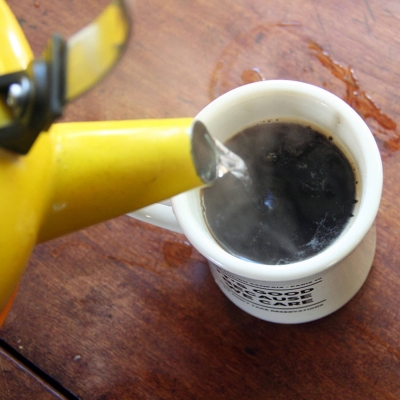
The French author Honore de Balzac drank his coffee black, cold and thick as soup to keep him awake while writing through the night. He is said to have consumed 50,000 cup in his lifetime. The French philosopher Voltaire drank an estimated 72 cups a day and Beethoven is said to have used 60 beans for every cup.
Today, coffee drinkers in many countries use the instant variety, which is what remains after ground coffee beans have been ‘brewed’ and the water evaporated. In Japan, Australia and Britain, about 90% of coffee drunk is instant. In the USA, however, it accounts for only a quarter of the coffee drunk, while almost all Scandinavian and Italians prefer their coffee freshly ground.
Attempts to make instant coffee in the late 1800s failed because of poor flavour. Then, in 1906, George Washington, a Belgian born engineer of English parentage, was visiting a mountainous region of Guatemala when he noticed a brown deposit on the outside of a coffee pot that had boiled over. Tasting it, he thought its flavour was pleasant and the deduced that this was due to lower atmospheric pressure at high altitude. The lower boiling point of water at the higher attitude, he decided, allowed the water to evaporate with less heat damage to the dissolved coffee.
Three years later, he opened the G. Washington coffee refining company in Brooklyn, New York. His instant coffee’s immediate success was boosted during the first world war, when the US Army included it in infantry rations.
Making instant coffee involves ‘brewing up’ on a giant scale. Coffee is delivered to the manufacturer ready roasted, blended and ground. It is then percolated – the process of filtering hot water through the grounds – in batches of up to 2000lb (900kg) at a time. Some of the water is evaporated from the coffee to leave a highly concentrated liquid.
To produce powered is instant coffee, the liquid passes through a large cylinder in which it is subjected to hot air, which evaporates the remaining water. This leaves the powdered coffee ready for sealing into jars or packets.
Granular instant coffee is made by freeze drying. The concentrate is first frozen, and broken up into granules. The granules are then heated gently inside a vacuum chamber. Because water boils at low-temperature in a vacuum, the remaining moisture can be evaporated off without subjecting the coffee to create heat and impairing the flavour.
Picture Credit : Google

